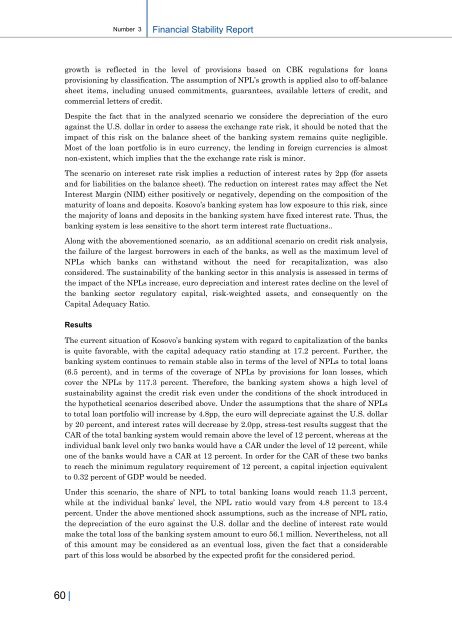financial stability report - Banka Qendrore e Republikës së Kosovës
financial stability report - Banka Qendrore e Republikës së Kosovës
financial stability report - Banka Qendrore e Republikës së Kosovës
Create successful ePaper yourself
Turn your PDF publications into a flip-book with our unique Google optimized e-Paper software.
Number 3<br />
Financial Stability Report<br />
growth is reflected in the level of provisions based on CBK regulations for loans<br />
provisioning by classification. The assumption of NPL’s growth is applied also to off-balance<br />
sheet items, including unused commitments, guarantees, available letters of credit, and<br />
commercial letters of credit.<br />
Despite the fact that in the analyzed scenario we considere the depreciation of the euro<br />
against the U.S. dollar in order to assess the exchange rate risk, it should be noted that the<br />
impact of this risk on the balance sheet of the banking system remains quite negligible.<br />
Most of the loan portfolio is in euro currency, the lending in foreign currencies is almost<br />
non-existent, which implies that the the exchange rate risk is minor.<br />
The scenario on intereset rate risk implies a reduction of interest rates by 2pp (for assets<br />
and for liabilities on the balance sheet). The reduction on interest rates may affect the Net<br />
Interest Margin (NIM) either positively or negatively, depending on the composition of the<br />
maturity of loans and deposits. Kosovo’s banking system has low exposure to this risk, since<br />
the majority of loans and deposits in the banking system have fixed interest rate. Thus, the<br />
banking system is less sensitive to the short term interest rate fluctuations..<br />
Along with the abovementioned scenario, as an additional scenario on credit risk analysis,<br />
the failure of the largest borrowers in each of the banks, as well as the maximum level of<br />
NPLs which banks can withstand without the need for recapitalization, was also<br />
considered. The sustainability of the banking sector in this analysis is assessed in terms of<br />
the impact of the NPLs increase, euro depreciation and interest rates decline on the level of<br />
the banking sector regulatory capital, risk-weighted assets, and consequently on the<br />
Capital Adequacy Ratio.<br />
Results<br />
The current situation of Kosovo’s banking system with regard to capitalization of the banks<br />
is quite favorable, with the capital adequacy ratio standing at 17.2 percent. Further, the<br />
banking system continues to remain stable also in terms of the level of NPLs to total loans<br />
(6.5 percent), and in terms of the coverage of NPLs by provisions for loan losses, which<br />
cover the NPLs by 117.3 percent. Therefore, the banking system shows a high level of<br />
sustainability against the credit risk even under the conditions of the shock introduced in<br />
the hypothetical scenarios described above. Under the assumptions that the share of NPLs<br />
to total loan portfolio will increase by 4.8pp, the euro will depreciate against the U.S. dollar<br />
by 20 percent, and interest rates will decrease by 2.0pp, stress-test results suggest that the<br />
CAR of the total banking system would remain above the level of 12 percent, whereas at the<br />
individual bank level only two banks would have a CAR under the level of 12 percent, while<br />
one of the banks would have a CAR at 12 percent. In order for the CAR of these two banks<br />
to reach the minimum regulatory requirement of 12 percent, a capital injection equivalent<br />
to 0.32 percent of GDP would be needed.<br />
Under this scenario, the share of NPL to total banking loans would reach 11.3 percent,<br />
while at the individual banks’ level, the NPL ratio would vary from 4.8 percent to 13.4<br />
percent. Under the above mentioned shock assumptions, such as the increase of NPL ratio,<br />
the depreciation of the euro against the U.S. dollar and the decline of interest rate would<br />
make the total loss of the banking system amount to euro 56.1 million. Nevertheless, not all<br />
of this amount may be considered as an eventual loss, given the fact that a considerable<br />
part of this loss would be absorbed by the expected profit for the considered period.<br />
60 |

















